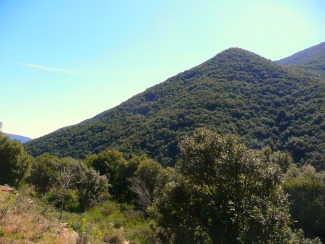VOCs in Montseny: between urban smog and biogeneration

Atmospheric volatile organic compounds (VOCs) are involved in ozone and aerosol generation, thus having implications for air quality and climate. VOCs and their emissions by vegetation also have important ecological roles as they can protect plants from stresses and act as communication cues between plants and between plants and animals. In spite of these key environmental and biological roles, the reports on seasonal and daily VOC mixing ratios in the literature for Mediterranean natural environments are scarce.
We conducted winter and summer measurements of VOC mixing ratios in an elevated (720 m a.s.l.) holm oak Mediterranean forest site in the Natural Park of Montseny, near the metropolitan area of Barcelona. Methanol was the most abundant compound among all the VOCs measured in both seasons. Regarding differences between winter and summer, while aromatic VOCs (mainly of anthropic origin, such as benzene and toluene) showed almost no seasonal variability, short-chain oxygenated VOCs (e.g. methanol, acetaldehyde, acetone, etc.) presented higher mixing ratios in summer, presumably due to greater emission by vegetation and increased photochemistry, both enhanced by the high temperatures and solar radiation in summer. Isoprenoid VOCs (isoprene and monoterpenes) showed the biggest seasonal change in mixing ratios: they increased by one order of magnitude in summer, as a result of the vegetation's greater physiological activity and emission rates. The maximum diurnal concentrations of ozone increased in summer too, most likely due to more intense photochemical activity and the higher levels of VOCs in the air.
The daily variation of VOC mixing ratios was mainly governed by the wind regime of the mountain, as the majority of the VOC species analyzed followed a very similar diel cycle. Mountain and sea breezes that develop after sunrise advect polluted air masses to the mountain. These polluted air masses had previously passed over the urban and industrial areas surrounding the Barcelona metropolitan area, where they were enriched in nitrogen oxides and in VOCs of biotic and abiotic origin. Moreover, these polluted air masses receive additional biogenic VOCs emitted in the local valley by the vegetation, thus enhancing ozone formation in this forested site. The only VOC species that showed a somewhat different daily pattern were monoterpenes because of their local biogenic emission. Isoprene also followed in part the daily pattern of monoterpenes, but only in summer when its biotic sources were stronger. The increase by one order of magnitude in the concentrations of these volatile isoprenoids highlights the importance of local biogenic summer emissions in these Mediterranean forested areas which also receive polluted air masses from nearby or distant anthropic sources.
References
"Contrasting winter and summer VOC mixing ratios at a forest site in the Western Mediterranean Basin: the effect of local biogenic emissions". Seco R, Peñuelas J, Filella I, Llusià J, Molowny-Horas R, Schallhart S, Metzger A, Müller M, and Hansel A (2011). Atmos. Chem. Phys., 11, 13161-13179, doi:10.5194/acp-11-13161-2011.


